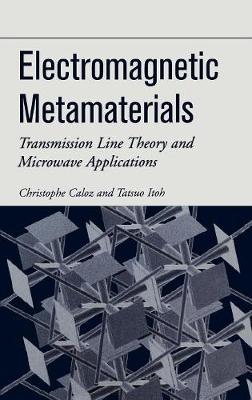Wiley - IEEE
2 total works
Electromagnetic Metamaterials - Transmission Line Theory and Microwave Applications
by Christophe Caloz and Tatsuo Itoh
The next six chapters give readers a solid foundation in the fundamentals and practical applications: Fundamentals of LH MMs describes the fundamental physics and exotic properties of left-handed metamaterials TL Theory of MMs establishes the foundations of CRLH structures in three progressive steps: ideal transmission line, LC network, and real distributed structure Two-Dimensional MMs develops both a transmission matrix method and a transmission line method to address the problem of finite-size 2D metamaterials excited by arbitrary sources Guided-Wave Applications and Radiated-Wave Applications present a number of groundbreaking applications developed by the authors The Future of MMs sets forth an expert view on future challenges and prospects This engineering approach to metamaterials paves the way for a new generation of microwave and photonic devices and structures. It is recommended for electrical engineers, as well as physicists and optical engineers, with an interest in practical negative refractive index structures and materials.
Electromagnetic Metasurfaces - Theory and Applications
by Karim Achouri and Christophe Caloz
Discover a comprehensive exploration of recent developments and fundamental concepts in the applications of metasurfaces.
In Electromagnetic Metasurfaces: Theory and Applications, distinguished researchers and authors Karim Achouri and Christophe Caloz deliver an introduction to the fundamentals and applications of metasurfaces and an insightful analysis of recent and future developments in the field. The book describes the precursors and history of metasurfaces before continuing on to an exploration of the physical insights that can be gleaned from the material parameters of the metasurface.
You'll learn how to compute the fields scattered by a metasurface with known material parameters being illuminated by an arbitrary incident field, as well as how to realize a practical metasurface and relate its material parameters to its physical structures. The authors provide examples to illustrate all the concepts discussed in the book to improve and simplify reader understanding.
Electromagnetic Metasurfaces concludes with an incisive discussion of the likely future directions and research opportunities in the field.
Readers will also benefit from the inclusion of:
- A thorough introduction to metamaterials, the concept of metasurfaces, and metasurface precursors
- An exploration of electromagnetic modeling and theory, including metasurfaces as zero-thickness sheets and bianisotropic susceptibility tensors
- A practical discussion of susceptibility synthesis, including four-parameters synthesis, more than four-parameters synthesis, and the addition of susceptibility components
- A concise treatment of scattered-field analysis, including approximate analytical methods, and finite-difference frequency-domain techniques
Perfect for researchers in metamaterial sciences and engineers working with microwave, THz, and optical technologies, Electromagnetic Metasurfaces: Theory and Applications will also earn a place in the libraries of graduate and undergraduate students in physics and electrical engineering.

